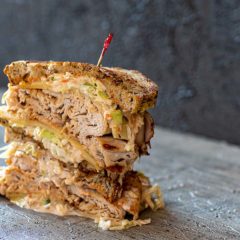The bagel is perhaps the most iconic Jewish food ever. This week, Chompie’s explores the story of bagels in America and explains their tasty roots in Judaism.
Let’s start with the basics: while there are a few similarities (they are both round and have a hole in the middle) a bagel is definitely NOT a donut. While a donut is deep-fried and traditionally sweeter (often dusted with sugar and filled with jelly or cream) a bagel is almost exclusively made from a heavy yeasted wheat dough. They are boiled and baked until crisp on the outside, which causes much of the dough’s moisture to be sealed inside. Boiling the dough causes the crust to be set, while the inside remains uncooked, causing bagels to end up with a chewy, moist interior. Bagels can be made with a variety of flavors to suit any palate, whether you prefer sweet or savory, traditional or contemporary, rich or light.
Legend has it that in 1863, a Jewish baker in Vienna wanted to thank the king of Poland for keeping his countrymen safe from Turkish invaders. He was inspired to develop a hard roll in the shape of a riding stirrup (known as a ”bruggel” in German) to commemorate the king’s favorite hobby, thus inspiring the bagel’s unique shape. Mothers began to use them as teething rings, which is still done to this day. Bagels became so popular, songs were even written about them.
Bagels arrived in the United States in the late 19th Century courtesy of Jewish immigrants from Poland. They were sold on the streets of New York’s Lower East Side, stacked up on poles or hung up from strings (which explains the holes,) making it easy for customers to buy and enjoy them on the street. Whether they’re served plain or schmeared with cream cheese and topped with lox, capers, tomatoes, and thinly sliced red onions, bagels have never strayed far from their humble roots as simple, comforting peasant food. The Yiddish word for bagel is “beigel” and some say the bagel is a descendant of the German pretzel, a similar yeasted dough bread that is boiled then baked. This process helps bagels stay fresh longer, which for poor Jews, was very important.
As European Jews immigrated to North America, many of them settled in Canadian cities like Toronto, Montreal & Quebec, creating a variety of bagels different from the New York style, giving birth to the Montreal Style bagel. There were so many bagel makers in NYC that in 1915, they formed their own trade union, Local 338, which at one point had a membership of 300 craftsmen.

Flash forward to the 1970s, when Lou and Lovey Borenstein visited Arizona. Being from Queens, they knew their way around a great New York City bagel. While they fell in love with the Valley and its warm winter temperatures and laid-back desert lifestyle, they were disappointed they couldn’t find a little slice of home in Phoenix: an authentic New York City bagel. “No one baked them fresh, they were all frozen,” Lovey said, and thus the idea to introduce freshly-baked bagels to the Grand Canyon State was born. Today, hundreds of authentic, boiled-then-baked bagels are made right here and served at Chompie’s five Valley locations. Lou, Lovey, and their three adult children now run Chompie’s, serving breakfast, lunch, and dinner seven days a week with a full New York deli-style menu with that humble, immigrant- inspired food – the bagel – as its centerpiece. Come into the Chompie’s location nearest you and bite into a tasty reminder of the Old Country, updated to reflect the favor of today.













